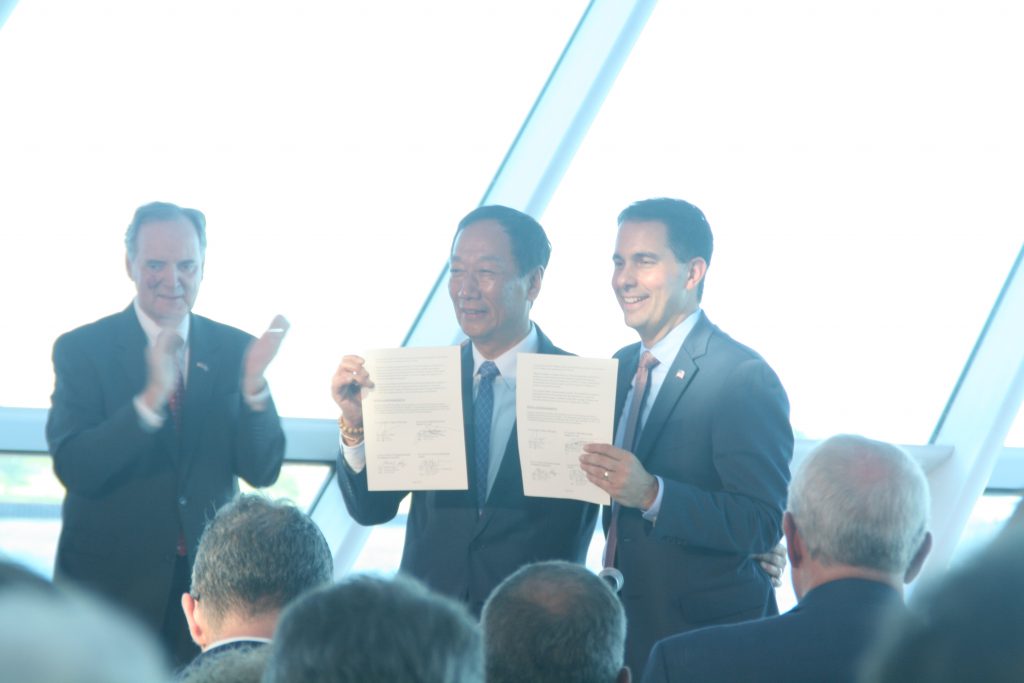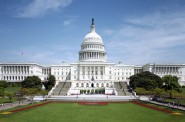The High Cost of Foxconn
Each job created could cost the state anywhere from $17,273 to $54,159 per year.

Foxconn chairman Terry Gou and Governor Scott Walker hold a memorandum of understanding. Photo by Jeramey Jannene.
The cost of the proposed new tax credits for the tentative deal with Foxconn could be far larger per job created than some people have suggested. Those costs will vary greatly depending on the ratio of spending for payroll versus the capital expenditures.
The more that Foxconn invests in its facilities and state-of-the-art automation, rather than payroll, the more the proposed deal will cost state taxpayers per job created. A new Wisconsin Budget Project report examines the potential tax credit costs based on four scenarios that make different assumptions about the number of new jobs, the duration of the project, and the amount of Foxconn spending for capital improvements.
In brief, we found that:
- The cost to the state of the new tax credits (excluding other subsidies) could range from about $219,000 per job for 13,000 Foxconn jobs to $587,000 each if the new enterprise employs 3,000 people.
- On an annual basis, the proposed credits would cost state taxpayers $17,273 per job per year for 15 years under the scenario of 13,000 Foxconn jobs described by state officials, but the cost could exceed $54,000 per job per year under a scenario of 3,000 jobs that last for 10 years rather than a minimum of 15 years.
- On top of the very substantial cost of the new tax credits, there’s the cost of existing tax breaks for manufacturers (which would already essentially zero out Foxconn’s corporate tax liability), plus the costs of huge local infrastructure investments, the cost of prioritizing work on the I-94 corridor, potential costs to state taxpayers from making a guarantee to cover up to 40 percent of local losses from spending for the project, and the unknown costs from unprecedented exemptions from environmental regulations.
| Scenario 1 | Scenario 2 | Scenario 3 | Scenario 4 | |
| New Foxconn jobs | 13,000 | 3,000 | 3,000 | 3,000 |
| Duration of jobs | 15+ years | 15+ years | 10 yrs (2020-29) | 10 yrs (2020-29) |
| Total payroll through 2034 | $8.9 billion | $2.4 billion | $1.6 billion | $1.6 billion |
| Total capital investment | $9 billion | $9 billion | $9 billion | $5 billion |
| Total jobs tax credits | $1.5 billion | $412 million | $275 million | $275 million |
| Capital expenditure credits | $1.35 billion | $1.35 billion | $1.35 billion | $750 million |
| Total of the new tax credits | $2.85 billion | $1.76 billion | $1.62 billion | $1.03 billion |
| New tax credits per job | $219,231 | $587,381 | $541,588 | $341,588 |
| New credits per job per year | $17,273 | $39,159 | $54,159 | $34,159 |
Our report addresses the misimpression some people have that the proposed state “tax credits” – which will pay up to 17 percent of payroll costs and up to 15 percent of capital expenditures – will be offsets against the corporate income taxes that will be owed by Foxconn. That is not the case; our analysis explains that Wisconsin currently has two very generous tax breaks that make it highly unlikely that manufacturers like Foxconn will owe any corporate income tax on their net profits. That means the state will be writing huge checks to Foxconn each year for the cost of the tax credits.
One positive aspect of the proposed legislation is that new tax subsidies are tied to job creation and capital spending in Wisconsin, which is not the case for the massive giveaway known as the Manufacturing and Agriculture Credit. Nevertheless, the structure of the proposed deal allows Foxconn to do very well by investing in automation and taking full advantage of the capital expenditure tax credit, rather than focusing on jobs and trying to maximize the new jobs tax credits.
Even under the state’s relatively optimistic assumptions about job growth, the proposed subsides are far greater per job created than any significant subsidy deal the Wisconsin has proposed in the past, and the numbers get much worse if we assume that Foxconn prioritizes automation. Wisconsin policymakers and state citizens need to think carefully about the different scenarios, after removing our rose-colored glasses.
One of the questions that we need to think about very carefully is whether a corporation that is induced to locate here by such large subsidies is going to stay when those subsidies end, or when another state offers an even better deal. And policymakers should think about how these subsidies would affect the demands of other companies who play the game of threating to locate elsewhere.
Finally and most importantly, we have to think very carefully about the effects of the proposed legislation on the state budget and whether there are more effective ways to invest billions of dollars of state and local tax revenue.
More about the Foxconn Facility
- Foxconn Acquires 20 More Acres in Mount Pleasant, But For What? - Joe Schulz - Jan 7th, 2025
- Murphy’s Law: What Are Foxconn’s Employees Doing? - Bruce Murphy - Dec 17th, 2024
- With 1,114 Employees, Foxconn Earns $9 Million in Tax Credits - Joe Schulz - Dec 13th, 2024
- Mount Pleasant, Racine in Legal Battle Over Water After Foxconn Failure - Evan Casey - Sep 18th, 2024
- Biden Hails ‘Transformative’ Microsoft Project in Mount Pleasant - Sophie Bolich - May 8th, 2024
- Microsoft’s Wisconsin Data Center Now A $3.3 Billion Project - Jeramey Jannene - May 8th, 2024
- We Energies Will Spend $335 Million on Microsoft Development - Evan Casey - Mar 6th, 2024
- Foxconn Will Get State Subsidy For 2022 - Joe Schulz - Dec 11th, 2023
- Mount Pleasant Approves Microsoft Deal on Foxconn Land - Evan Casey - Nov 28th, 2023
- Mount Pleasant Deal With Microsoft Has No Public Subsidies - Evan Casey - Nov 14th, 2023
Read more about Foxconn Facility here
Wisconsin Budget
-
Charting The Racial Disparities In State’s Prisons
 Nov 28th, 2021 by Tamarine Cornelius
Nov 28th, 2021 by Tamarine Cornelius
-
State’s $1 Billion Tax Cut Leaves Out 49% of Taxpayers
 Sep 21st, 2021 by Tamarine Cornelius
Sep 21st, 2021 by Tamarine Cornelius
-
TANF Program Serves a Fraction of Poor Families
 Aug 30th, 2021 by Jon Peacock
Aug 30th, 2021 by Jon Peacock





















Nevada’s deal with Elon Musk and the Tesla investment. The Reno Gazette Journal (via AutoBlogGreen) breaks down incentives as follows:
$725 million for a 20-year 100 percent sales tax abatement
$332 million for a 10-year 100 percent property tax abatement
$120 million in transferable tax credits
$75 million in transferable tax credits worth $12,500 per job times 6,000 jobs).
$27 million for a 10-year, 100 percent modified business tax abatement
$8 million in discounted electricity rates for eight years
Also part of the deal – the Governor said that Nevada would adjust its laws so that Tesla can sell cars at its company stores.
So, not subsidies for health care; only subsidies for big money.?
Use tax money to get companies here,so workers can buy insurance without tax dollars?
Use my taxes to help folks get health insurance please. Use my taxes to fix roads, support Public Education.
This entire situation is completely nuts and inappropriate besides scamming the taxpayers of Wisconsin just so Walker can have a good talking point for the next gubernatorial race. Since when do companies need to be bribed and paid to start up operations in a certain area? I studied business and that has never been the way a company makes a decision on where to build, but they are certainly not going to turn down free money are they. Foxconn is a well off corporation and does not need all the help that Walker is pushing onto them. If that is their sole criteria for building here, then Walker is a fool and is being conned. SE Wisconsin does not want their environment destroyed in the process of possibly gaining a few low paying jobs. In the end that in itself is not worth it. You can’t believe all the workers are really going to get paid $54K a year do you. If that’s the case, then why don’t they pay their people in China or other countries a higher wage? You will be lucky if you make $20K a year plus benefits in one of these jobs. The higher pay will be for engineers and technical people and that is a low wage for those jobs too. Why is the Wisconsin taxpayer on the hook for giving a successful company our tax dollars to build here to make money and make a profit at our expense?
Let us take a look at Milwaukee and its give aways at the expense of the tax payer., Miller Park (county tax payer), the new Bucks’ arena (city, county and state tax payer), the trolley (city tax payer), the new Northwestern mutual building(city tax payer), the Shops of Grand Avenue (TIF,city tax payer) Intramodal or Grey Hound (TIF,city tax payer) , ASQ Building(city of Milwaukee), the new Coulture(city tax payer), the Wisconsin Center, the old Mecca, the Marcus Center, the Historical Society and Wisconsin theatre. (Milwaukee County tax payer).
Exactly Jason Troll. Enough is enough and it’s time to put an end to taxpayers subsidizing private businesses starting with Foxconn.
Fivecents, the big story in Wisconsin may be subsidizing Foxconn but nationally, the left has no problem with doling tens of billions of dollars to the insurance companies through the Federal treasury to fund Obamacare. Why did we create this give away and not fund it through federal taxation?
Miller Park and Buicks arena financing packages were not creations of city government. They were managed entirely by the state government. The ball park depended on a regional sales tax surcharge, for which Republican Gov. Tommy Thompson urged approval, asking taxpayers outside metro Milwaukee to “stick it to ’em.” The arena uses $250 million in public tax support, a huge number but: 1.) only a fraction of that comes from the city government, mostly in the form of infrastructure support, and 2) the entire package dictated by Gov. Walker and the GOP-led state legislature.
TIF districts aren’t giveaways; the current tax base is unaffected. New property tax generation in the TIF as a result of the development (which arguably wouldn’t happen without TIF) pays for improvements over a number of years, after which the new tax base represented by those improvements begins adding to a city’s general fund for all its operations.
One can question the efficacy of any particular project and subsidy method in terms of costs and impacts, but Milwaukee arguably has been thoughtful and clever in developing its tax base, a huge necessity because for years local property taxes have been the city’s overriding source of operating revenue.
As for the “Obamacare” reference: The federal subsidies for eligible “Obamacare” clients come from relatively small tax hikes on wealthy taxpayers plus taxes from the sale of certain medical equipment. That not only has worked well in general to reduce the rolls of the uninsured, this methodt has no relationship to the kind of financing Walker proposes in the Foxconn deal, which in turn in its main component has no relationship to TIF/TID financing methods.
So let’s try hard to compare apples to apples going forward. When we do, we see that Republican and Democratic officeholders nationwide have used TIF financing and tax-credit subsidies, whether in red states or blue state. But tax credits on the scale of what Walker proposes for just one development of indeterminate workforce composition and size (as Mr. Peacock’s article notes) are extremely unusual.
Walker has docked public schools, the university system, public employee compensation and shared revenues to cities by close to the $3 billion and more he now proposes to spend subsidizing just one foreign corporation’s labor costs and other expenses for a decade or more. If lawmakers enact this proposal as it stands, Wisconsin will be X-marked as a sucker state that any other business can exploit in the same fashion. We’ll be hostage to this proposal and more like it for years to come.
The investment might pay dividends through a marginal increase in statewide jobs, but the present scheme would do that by pouring money into one localized operation that is likely to make more net revenue for Illinois just across the border than this state. And the 3,000 promised jobs to start wouldn’t even replace the 3,600 or so manufacturing jobs the state lost in the most recent accounting. There’s one word for this: Overkill. And a phrase for it: Political desperation.
In today’s paper Mike Lowell raves about the deal and points to Google & Pittsburgh as an example of how Foxconn could revolutionize the region. But is that really an apples to apples comparison? Did Pittsburgh give Google a $3 billion incentive package?
Also, the Washington Post ran a really interesting story over the weekend. It’s about how manufacturing is changing and uses a company in Wisconsin to demonstrate those changes. It’s a small company, only 50 or 100 employees, but it always has openings it can’t fill. It got desperate so it turned to robots because of the constant unfilled openings. It talks about how this is happening more and more and why companies can’t fill these jobs. Makes you wonder if those are warning signs.
Actually Ron, TIF’s can be giveaways. My understanding is the Intramodal and the Grand Avenue are failed TIF’s. The city of Milwaukee will not get back the amount that was promised.
It looks to me like yes TID 60 (Intramodal station) did need funds from another TIF as it was under performing. That said TID 37 (Grand Ave) has not needed assistance.
I agree that TIFs and tax subsidies of other kinds don’t always succeed. Nor should they be expected to succeed in every event. TIF/TIDs come into play when a government takes a (hopefully) measured risk in place of doing nothing. The key, though, is serving an identified need in a rational, well-planned way that doesn’t break the bank — which the Foxconn deal doesn’t much look like. It is the case (Foxconn included) that companies increasingly play Peter off against Paul to see which government will put up the most public dollars to lure development. That distorts the process. But the examples cited by Jason weren’t distortions at all. They were community needs.
In the case of the Milwaukee Intermodal Station, the original ’65 building was badly in need of renovation including upgrades to meet ADA requirements. The city and state perceived value in combining bus and rail services (and eventually the streetcar) with a $17 million project. By the way, the state Department of Transportation owns that building, I am not sure what anyone would have had the state do without the TID, but arguably the state should have invested state transportation funds into the project rather than rely on city property tax ledgerdemain (made possible through a tricky private-lease arrangement). Note that nearly $20 million in federal aids for renovating the station’s train shed went by the boards when Gov. Walker killed the high-speed rail project, requiring the state to cover an additional cost. That’s called shooting yourself in the foot.
In the case of Grand Avenue, the TID has kept downtown more vibrant in a number of ways. This TID from 1998 covers a second redevelopment. The original creation of Grand Avenue in the ’80s was successful for a number of years. Retail markets certainly have mutated since then, but the area is still better off than before the TID or the original project. You could say just about the same thing with respect to suburban shopping malls or main street commercial strips.
The cost of incentives-per-job is a meaningless metric. The potential value to the State would be the expected tax revenue generated by direct and indirect jobs and other revenue forms over time, offset by incentives over time.